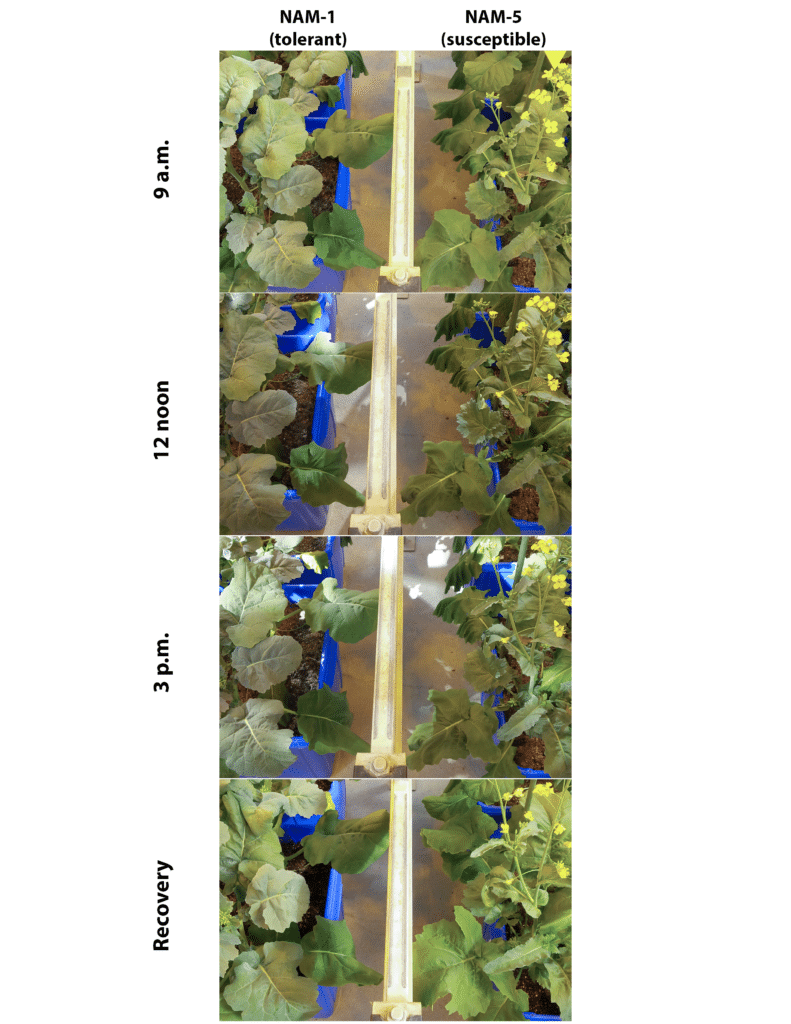Key Result
Heat had a significant effect on yield by preventing seed set and had a more negative effect than drought on seed oil composition. Researchers found possible genetic solutions to enhance drought and heat stress.
Project Summary
Overview
Canola’s resilience to heat and drought depends on when these stresses occur within the crop lifecycle. Plants may recover after stress during the vegetative stage, but stress during flowering and/or pod development usually has a negative effect on yield. This project investigated how drought, heat and a combination of the two can affect canola seed yield, oil composition and carbon assimilation. Researchers used a drought-tolerant (DT) and a drought-susceptible (DS) canola cultivar to compare day and night transpiration water loss under optimal watering and water deficit conditions.
Objectives of this research were:
- To evaluate spring canola nested association mapping (NAM) population founder lines for drought, heat and combined stresses in the greenhouse and later evaluate abiotic stress tolerance under field conditions.
- To complete a comprehensive analysis of plant metabolites exhibiting enhanced stress-responsive roles, leading to the discovery of biomarkers and select stress-tolerant canola varieties based on the abscisic acid level.
- To explore new rapid and non-destructive biomolecular imaging techniques to predict stress tolerance using mid-IR spectroscopy at the Canadian Light Source.
Results
Objective 1. Researchers used greenhouse and field experiments to compare 50 founder lines of the spring canola NAM population and a common parent (reference line). Results showed high variation in yield traits, especially pod weight, among the NAM lines. The most variable traits were stomatal conductance and transpiration rate. This suggests potential to breed canola with higher drought and heat tolerance.

Objective 2. Researchers compared plant growth under different temperatures (23°C versus 29°C daytime temperatures) and water amounts (30 and 90 per cent of soil water holding capacity) for N99-508, a reference NAM line.
Results show that drought affected the carbon assimilation rate mainly through the limitation of CO2 diffusion through the stomata and seed yield components. Heat altered the reproductive organs and process, leading to a reduction in the number of siliques and yield. Heat had a larger effect over drought on seed composition, which resulted in higher levels of saturated fatty oils. While drought effects can be mitigated with irrigation and/or using genotypes with greater water use efficiency, heat requires the breeding of heat tolerant canola.
Objective 3. Researchers used two cultivars for this experiment: drought-resistant Czyzowska from Poland and drought-sensitive BN-1 from India. They measured growth with fluctuations in day/ night temperatures and photoperiod, watering conditions and relative humidity to mimic drought conditions. They also measured photosynthetic activity, night gas exchanges, leaf waxes, cysteine and sucrose, and growth and yield.
Results confirmed previous studies demonstrating the involvement of sulphur in mitigating the effect of abiotic stressors on plants. The correlations between cysteine, abscisic acid and stomatal conductance suggest a role of cysteine and sulphur in modulating the stomata movement under water deficit conditions.
Also, the accumulation of significant levels of aspartic acid plays a crucial role during intermittent periods of drought. Aspartic acid mechanisms help prevent leaf death and preserve nitrogen and carbon resources. Canola benefits greatly when its leaves survive brief drought episodes. When favourable moisture conditions return, instead of waiting for new leaves to grow, the plant can promptly resume its photosynthetic activity.
The study also demonstrated the responsiveness of load and composition of epicuticular waxes to drought in Brassica napus and the importance of water losses through stomata during dark periods and early mornings.





